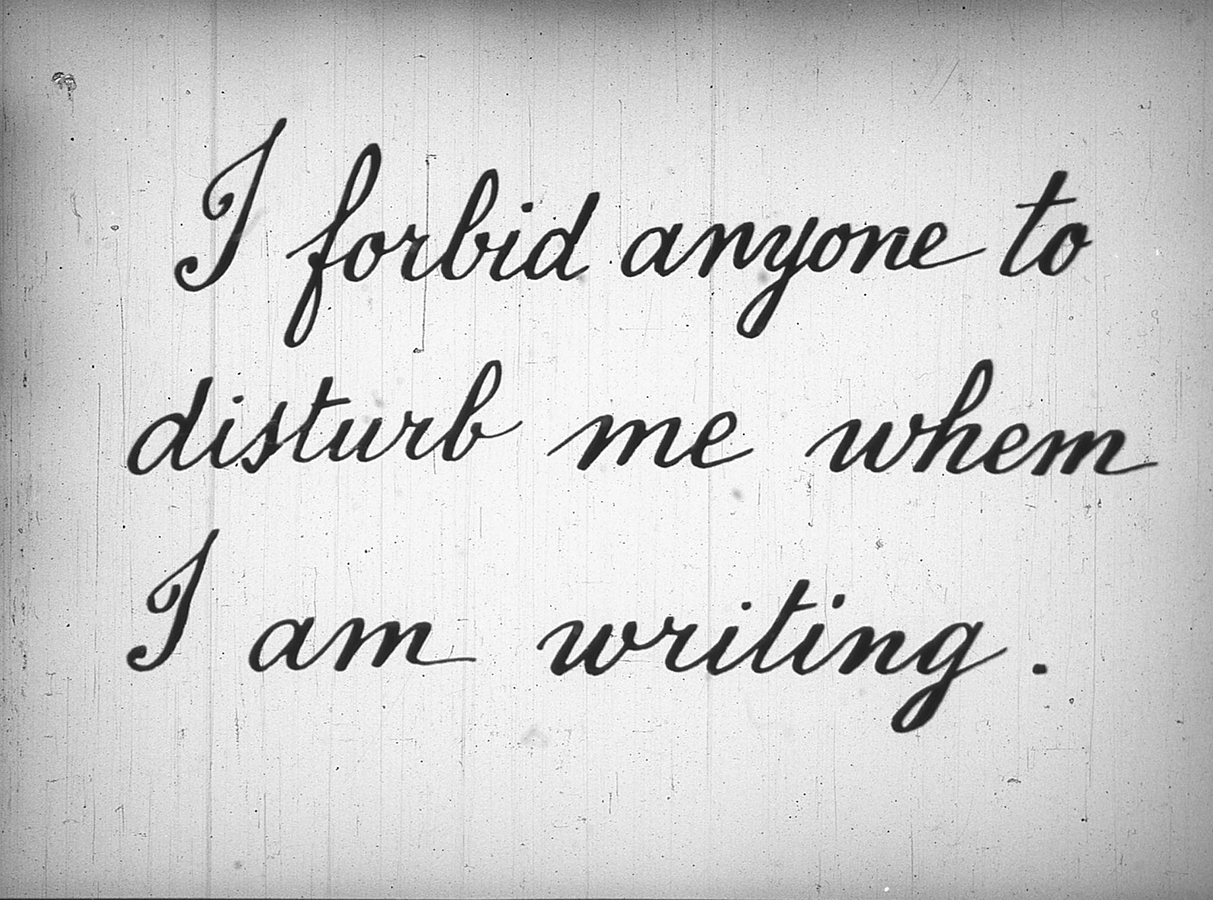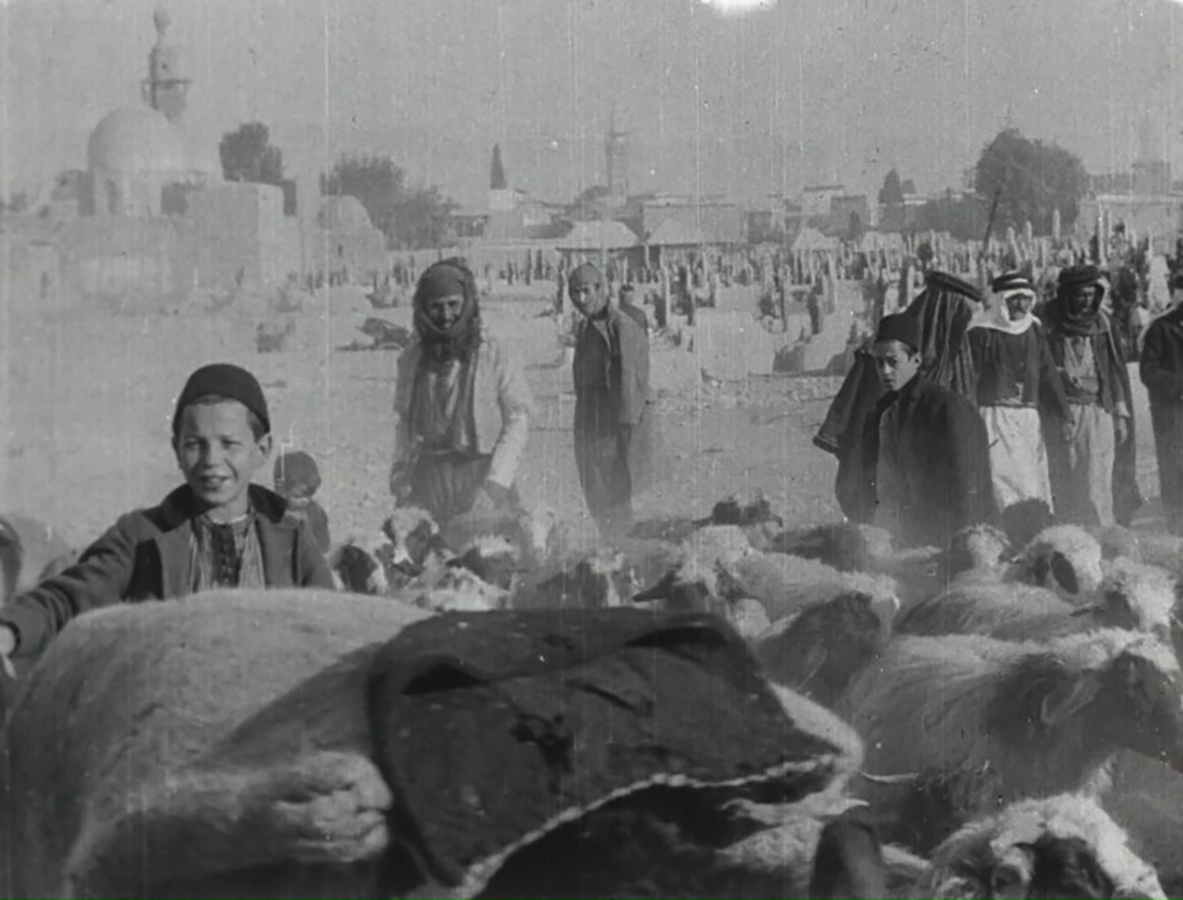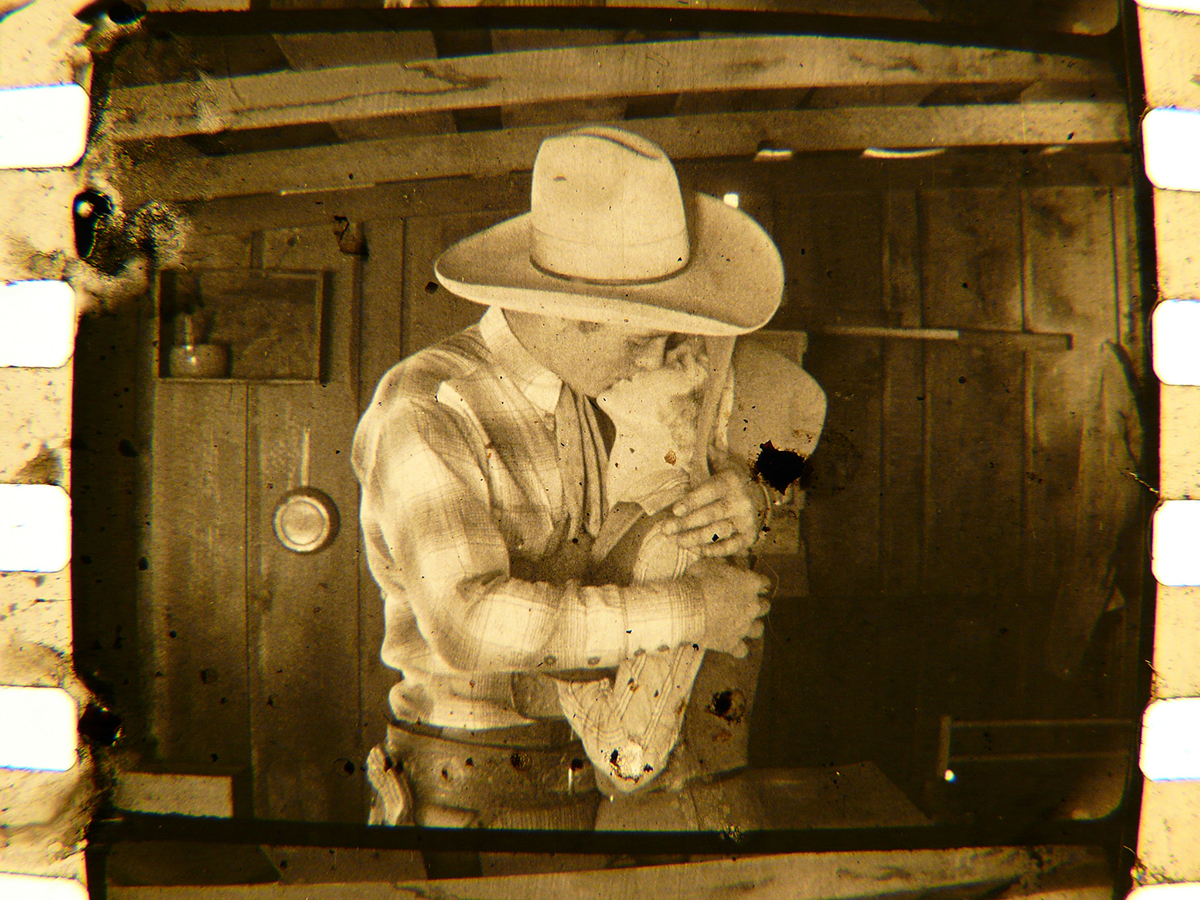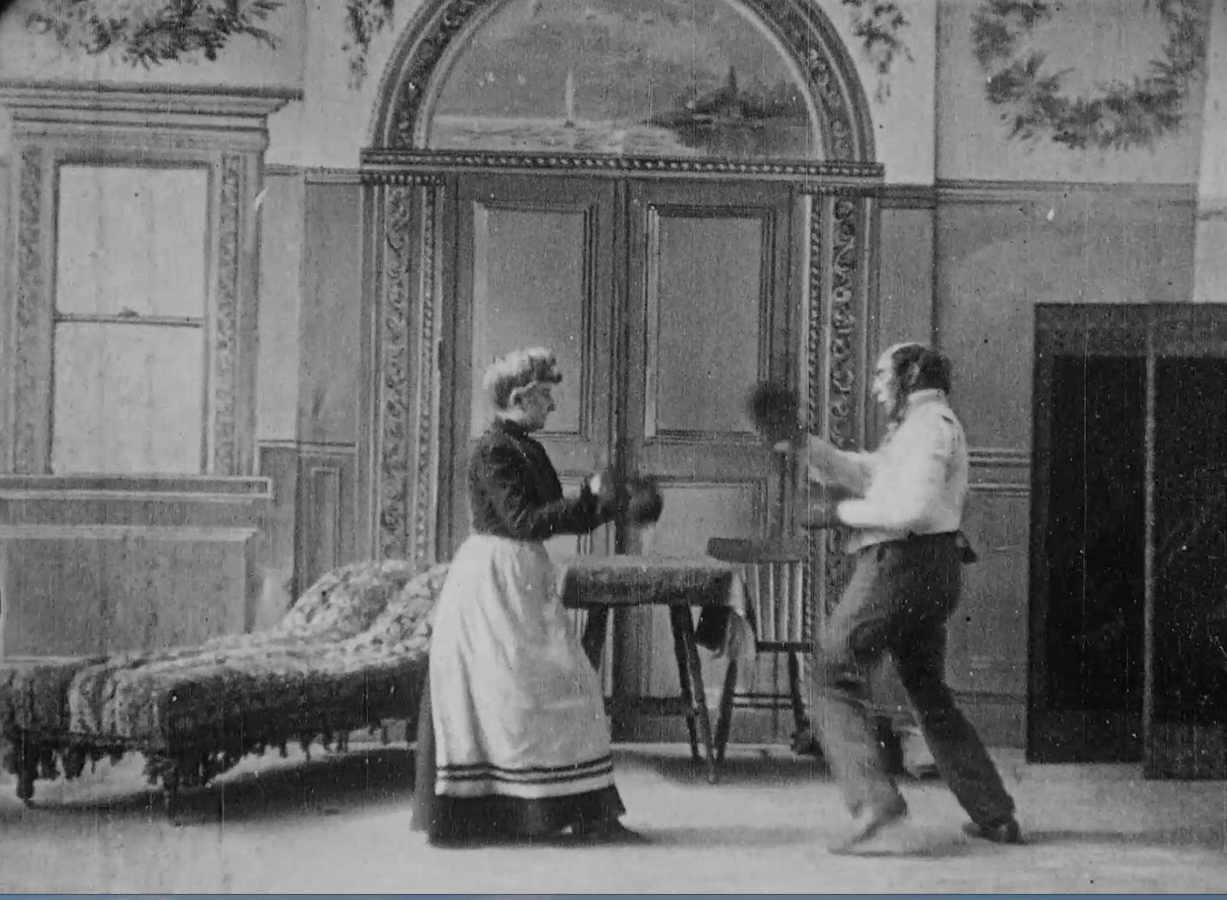Lost and Found Cinema

The concrete bunker looms up surreally from the rolling green countryside, a huge brutalist fortress sprouting from a hillside thick with wildflowers. This is the Library of Congress’s National Audio-Visual Conservation Center in Culpeper, Virginia, also known as the Packard Campus. Like something out of Dr. Strangelove, it was constructed during the Cold War to house stores of Federal Reserve cash intended to reinflate the economy after a nuclear war. (What would have been left to buy?) Philanthropist David Woodley Packard, a passionate supporter of film preservation, bought the complex after it was decommissioned in 1993 and renovated it as a state-of-the-art home for audiovisual conservation—removing the gun turret, converting firing ranges into storage vaults, and installing a jewel-box theater with carpets and chandeliers replicating those of beloved movie houses in Palo Alto and San Pedro, California. When Packard gave the building back to the government in 2007, it was the second largest gift to the nation after the Smithsonian Institution.
Inside, little trace of the structure’s Cold War origins remains in what is now a light and airy space, with sweeping views over the surrounding valley from windows framed with trailing vines. Underground, storage vaults that tunnel into the hillside hold more than seven million audio or moving-image items, including the libraries of many major Hollywood studios but also a substantial number of orphaned or unidentified films. Unlike books, films can easily become separated from their titles and credits, a fate particularly common among survivors from the first decades of moviemaking. All large archives end up in possession of such mysteries, and solving them is often too challenging or time-consuming to be a priority. The Library of Congress has developed a unique solution: an annual workshop called Mostly Lost, where experts and devotees of early cinema gather to watch a parade of unidentified, mainly silent films, and contribute any information they can toward identification—calling out an actor they recognize, a clue to the location or studio or year, a title that seems to match the synopsis.

The event serves its stated purpose—every year a good chunk of films are rescued from anonymity or misidentification, small steps in recovering the past that gladden the hearts of archivists, historians, and anyone who cares about understanding cinema. But it also offers something more: a perspective into movies that is radically different from the curated slates of film festivals or repertory houses. The experience is of rummaging through cinema’s lost and found—through the old umbrellas and the orphaned gloves and the eyeglasses, the diaries and musical instruments and diamond rings and stuffed animals, the strange and the ordinary and the sad and the priceless. Like the part of an iceberg that is underwater, this vast, submerged realm of cinema swims below the sparkling peaks of Vertigo and Citizen Kane.
Mostly Lost had an impromptu beginning in 2011 as a substitute when Slapsticon—an annual silent comedy festival then held in Arlington, Virginia—was canceled at the last minute, and attendees who had already booked travel to the area were invited to come to the library and play film detectives instead. The next year the workshop was officially launched; cofounder Rob Stone, the moving-image curator at the Library of Congress, came up with the name, playing on the moment from The Princess Bride when Miracle Max (Billy Crystal) announces that Westley (Cary Elwes) is only “mostly dead,” adding that “mostly dead means partly alive.” Stone reasoned that unidentified films, though they might reside safely in archives, were almost as good as missing, since they could not be discovered or shown.
From this modest beginning the workshop has taken off, attracting more people every year, and expanding to include films submitted by archives around the world (in 2016, the Museum of Modern Art in New York, the Cinémathèque française, the Royal Film Archive of Belgium, and the George Eastman Museum all sent materials, as did private collectors). The screenings are now interspersed with presentations by historians, archivists, and film preservationists; evening screenings of known but extremely rare silent films have been added; and the event kicks off with a full-morning tour of the library’s facility, making for a three-day orgy that I repeatedly heard described as “film-geek heaven.” Bringing together members of what we may as well call the film-geek community, to talk and meet one another as well as to watch and identify films, is an explicit aim of Mostly Lost. With its intimate size and unique purpose, the workshop fosters a keen sense of esprit de corps, a convivial mood peppered with in-jokes and the-game’s-afoot enthusiasm. “Crowdsourcing” is mostly an Internet phenomenon, and Mostly Lost’s co-coordinator Rachel Parker does post stills of unidentified films to a Flickr site—but even aside from the rights and restrictions that prevent them from posting everything online, Parker and Stone want to get people together in a theater to watch, laugh, howl, or groan at these films, which may not have screened publicly since their first release.





All this is how I wound up as part of a bleary but excitable group arriving for a tour of the Packard Campus early in the morning on the first day of Mostly Lost V in June 2016. We were the kind of people who get giddy at the thought of entering nitrate vaults, of breathing the same frigid air as the original camera negative for The Great Train Robbery (1903). And it was all pretty giddy-making. We passed through hallways lined with stacks of rusty film cans awaiting processing. Ancient projectors and kinetoscopes and cameras and record-cutting machines and Dictaphones were littered about, cheek by jowl with the most advanced conservation technology, such as IRENE, which can scan and digitally reconstruct sound from broken shellac discs. We saw staff meticulously repairing fragile film reels so they could run them through the optical printer; stood in the room designed for perfect acoustics where tapes from the Les Paul collection were being transferred; watched robots tirelessly inserting videotapes into VCRs for digitization. There is a clock-is-ticking urgency to audiovisual preservation: items need to be digitized while equipment for playback still exists, and before they have deteriorated beyond saving. Next time you pay your taxes, think about the money going here.
The Library of Congress’s collection is almost inconceivably vast, in part because a copy of any work must be deposited with the library in order to be copyrighted in the United States. For the tour, librarians had pulled a selection of items from the copyright collection that shed fascinating light on the fraught relationship between cinema as art and cinema as relentlessly evolving technology. A DCP (Digital Cinema Package) submitted for a recent movie is locked and unplayable, hence a useless object. By contrast, many pre-1912 films, such as D. W. Griffith’s Lonely Villa (1909), starring Mary Pickford, survive because paper contact prints—every frame of the film, printed as a positive onto a strip of light-sensitive opaque paper—were submitted for copyright protection. While the paper prints cannot be, and were never intended to be, projected, they are now the sole remaining copies of many early films, and have been transferred back to film, long after the original film prints vanished.






The fragility of film and the tragic loss of the majority of all silent movies—to fires, decomposition, and deliberate destruction—give surviving artifacts an almost magical aura. In the office of nitrate film vault manager George Willeman, the original camera negative for James Whale’s Frankenstein (1931) was on display, and we approached one by one to inspect the luminous frames—the actual film that ran through the camera—with the reverence of believers approaching a fragment of the True Cross. The droll Mr. Willeman, who has worked for the library for thirty-two years, showed examples of less fortunate films, some in brittle shards, others hardened into powdery orange slabs that resembled unappetizing coffee cakes. Into the water-filled nitrate trash can they would go: “You can’t turn a hamburger into a cow,” he explained. Nitrate is not only intensely flammable, it creates oxygen as it burns, so it will keep burning even in a vacuum or underwater. No wonder the library’s nitrate vaults, kept at a bone-chilling thirty-seven degrees, resemble a maximum security prison: long, drab concrete-floored hallways lined with gray locked doors, labels beside each door giving the only clue to the treasures within. The reels are sequestered in separate cells and in metal niches within those cells, designed to prevent fire from spreading. Since this is the largest nitrate vault in the country, many movie studios have shipped their entire back catalogs of nitrate prints to the library. Tucked away in nondescript gray cans are thousands upon thousands of films from Universal, Columbia, RKO, and Warner Brothers, ranging—as one browses the titles—from the best-known classics to the most obscure programmers.
Almost every film made before 1952 was shot on nitrate. This dangerous, volatile, ephemeral substance—which even if it does not catch fire chemically decomposes in spectacular fashion, but which remains unmatched for its visual clarity and incandescence—seems to embody early cinema in all its elusive, febrile glory. It inspires in some cinephiles a passion at least as combustible as the stuff itself.

The temptations to linger or wander off during the tour were many; silent comedy expert Steve Massa was drafted to sheepdog the group. Massa—whom I would be tempted to call the Phil Schaap of silent comedy, except that he wears his mind-boggling erudition far more lightly than Schaap does his staggering knowledge of jazz—is an MVP of Mostly Lost. His virtuosic ability to recognize minor, uncredited silent comedy players becomes a kind of running gag at the workshop; the fabled time he picked out hefty Chaplin costar Henry Bergman from a rear view reverberates in an endless series of in-jokes about his knack for identifying actors from their hindquarters. Most silent film fans are used to feeling like the possessors of arcane secrets, but witnessing the encyclopedic knowledge of Mostly Lost stalwarts like Massa, silent film accompanist and historian Philip Carli, preservationist and producer Serge Bromberg, and historian Robert J. Kiss, one quickly gets to feel like the merest neophyte.
But as Rob Stone pointed out in his presentation on the Vim Films Corporation—one of countless fly-by-night companies that led brief but feverishly productive lives during the silent era (this one was based for a time in Florida, and had in its ranks a portly young player named Oliver “Babe” Hardy)—what even silent movie experts know amounts only to fragments of the story. Cinema’s first decades were explosive, chaotic, a wild and woolly artistic and technological frontier. Before the studios converged on Hollywood, films were made all over the country, in New York, New Jersey, Florida, Chicago, Santa Barbara, Santa Cruz, even North Dakota, where Angela Murray Gibson, the subject of a presentation by Charles “Buckey” Grimm, ran a studio and both directed and shot her own films. Women were everywhere in the loose, freewheeling, and less-than-respectable early days of the movies, as writers, directors, editors, and technicians, before the big money, studios, and unions drove them out. (The admirable Women Film Pioneers Project aims to raise awareness of these women and their contributions.)
Another camera-wielding lady was the subject of a talk, Jon Mirsalis’s fascinating presentation of Loretta Young’s home movies. Given a 16 mm camera by Spencer Tracy, Young experimented with the rare and elaborate lenticular color process, producing some dazzling early three-color footage of stars like Tracy and herself, and she took her camera onto the sets of her movies (Bulldog Drummond Strikes Back, Caravan, Clive of India, Call of the Wild), capturing the unglamorous yet still enthralling business of moviemaking: a lot of standing around while hair and makeup artists fuss over the stars and camera crews work out complex crane and tracking shots. She caught Charles Boyer powdering his face and Clark Gable mugging in a fur hat. Mirsalis knew Young in her later years and accompanied these clips with anecdotes and audio recordings of her talking—recalling how when sound came in she despaired of being able to act without mood music on the set, or how when, at only fourteen, she starred in Laugh, Clown, Laugh (1928), costar Nils Asther gave her this advice on love scenes: “When you look at me, think about a chocolate ice cream soda.”






If the career of Angela Murray Gibson and the movies of Loretta Young came as a pleasant surprise, so did the number of women attending Mostly Lost—far more than the “film-geek heaven” label had led me to expect. There was a wide age range too, the median being brought down considerably by the presence of eleven-year-old Shane Fleming, who has been possessed by old movies since a visit to the Thomas Edison laboratory museum when he was six. Shane’s bemused father told me that he and his wife had nothing to do with inspiring this passion—further evidence for a theory based on my own experience and that of many friends: that certain people are, from the earliest age, innately drawn to and bewitched by old movies and the world revealed through them.
Some people discovered this affinity by chance when they saw old movies on television; others were encouraged in their passion by parents or mentors. Ben Model, a professional silent film accompanist, happened to grow up in the same town as Walter Kerr, author of the magisterial book The Silent Clowns, and watched movies at his house with scores that Kerr had compiled on reel-to-reel tapes. Later, despite his shyness about performing, he was moved to try accompanying films out of a desire to help movies that were “dying” being shown in silence. (Model, along with Philip Carli and Andrew Simpson, played for every unidentified film shown at Mostly Lost, giving an incomparable boost to often scratchy and, in all honesty, sometimes primitive clips. Model also distributes rare silent films through his company Undercrank Productions, and was a sponsor of Mostly Lost, providing among other things an ebullient closing-night reception at the vintage State Theatre in Culpeper.) Another attendee working to rescue old films from mere survival in vaults, and to restore some of their raffish vitality, was Alicia Fletcher, a media archivist at the Toronto International Film Festival. Fletcher curates a silent film series and recently launched the Ladies of Burlesque series, which pairs movies with live burlesque performances—just as films were once commonly introduced by vaudeville acts.
Of the 119 people registered for the 2016 workshop, at least half were in some way professionally involved with film—as scholars or programmers, archivists or filmmakers, dedicated to ensuring that the past has a future—but many were simply fans, drawn by the chance to see the rarest of rarities. Their attitude to old movies lay somewhere between open-minded and omnivorous, and many strongly endorsed Rob Stone’s argument for preserving any and all films: “To just skim the top does a disservice to future generations. We need a cross section. These were the films people were watching—this was us thirty or forty years ago.” This view is in part a matter of archival ethics: who are we to make decisions about what is worth preserving for the future? It is also about having a complete and honest historical view of cinema, seeing the whole ecosystem and not just the glamorous top-level predators. (“One must save everything,” a speaker quoted Cinémathèque française cofounder Henri Langlois as saying.) Eric Grayson, discussing his work reconstructing and restoring the early talkie serial King of the Kongo (1929), coined the term “guerrilla film preservation,” recounting how he tracked down six of the serial’s sound discs in Michigan and packed them in pizza boxes for the drive back—knowing no archive was likely to bother with a hokey B movie filled with men in gorilla suits and “African temples” made up of patched-together stock footage from Angkor Wat and a California Spanish mission, even if Boris Karloff does turn up in an early role. But this was precisely the sort of entertainment lovingly resuscitated fifty years later by the Indiana Jones movies and affectionately spoofed in Woody Allen’s The Purple Rose of Cairo (1985).
As more films become available, we get a better sense of what the first generation to grow up with the movies actually saw when they went to the nickelodeon on a Saturday afternoon, but we inevitably see these films through different eyes. With the earliest movies, you can watch filmmakers discovering what they could do with cameras, and often seemingly doing it just because they could. Film grammar develops before your eyes: close-ups, crosscutting, camera movements, split screens, oblique angles, the building of tension through pacing and editing. We may never be able to pin down definitively the first time a technique was used or whose idea it was, but by identifying more early films we can get a truer and more complicated picture than the textbook great-man film-history time line.
“We have a lot of rare films here,” George Willeman quipped during the tour, “meaning not well done.” The saddest day of his life, he said, came when he realized that being old and rare does not make a film good, and that if a print is pristine, it’s probably a stinker, since the most popular films have been projected to pieces. Most of the unidentified films we watched were, indeed, no masterpieces, though there were certainly flecks of gold amid the gravel in the sluice. And the sheer randomness of the films, most dating from the teens and twenties, or even earlier, was mesmerizing—the origins and development of cinema on shuffle. There were slapstick comedies, full of acrobatic brawls and chases and jokes about boardinghouse food, and tearjerkers with faithful dogs pining on the graves of their masters. There were countless indistinguishable westerns that no one could identify. There were home movies of the fashionable upper classes at summer resorts, and travelogues of the Middle East, India, Ethiopia, and people walking down Persia Street at the St. Louis World’s Fair. There was a stunningly tasteless comedy with sight gags that evoked a baby being mauled and a dog getting blown up. There was a bicycle that rode by itself, a train that jumped its tracks to run under the ocean and through the clouds, cartoon chickens and a man in a bear suit dancing with a ballerina . . . After a while the films all ran together like fitful dreams; it was like snorkeling through the subconscious of the early twentieth century.


















However, we were there not just to appreciate the films but to identify them if we could. While the voluble audience responded to the humor or cleverness or dullness or weirdness of the films, they were also scanning them for clues, looking at them simultaneously as art and as artifacts. At Mostly Lost V, as in past years, somewhere between a quarter and a third of the films were identified, including works by Alice Guy-Blaché, Charley Chase, and Gene Gauntier. One of the more intriguing fragments identified was a reel from a drama about an elegant lady thief plying her trade in a resort hotel, In the Power of a Hypnotist (1913), produced by and starring Gauntier, a pioneer who acted in, directed, wrote, and produced films throughout the teens. People searched online for synopses and credits and titles to confirm the flying guesses. They spotted dates on calendars hanging on walls, judged years by fashions, noticed the logos of companies—the Pathé rooster, the IMP initials—incorporated into sets, a common practice in early days to prevent pirating. They recognized Los Angeles locations that turn up often in the earliest proto-Hollywood films, like Echo Park and Westlake Park. The lovely raw freshness of these LA streets and parks suggested another argument for the save-everything mentality: even if a film is nameless and it’s not much good as a drama or comedy, there can be value in what it inadvertently captures. Behind the actors is the world a hundred years ago: reality blows through these films like the wind you can often see ruffling tablecloths and carpets in mocked-up interiors shot outdoors.

Why are so many films in archives unidentified? (To be more accurate, some of the films at Mostly Lost are underidentified or misidentified.) Some are incomplete or fragmentary, and credits, coming at the head or tail of the film, are often the first things to deteriorate. Silent films circulated all over the world: intertitles would be translated or simply rewritten, meaning films that turn up in other countries are often disguised. And that rough-and-tumble, Wild West quality of the prestudio era contributed too, as Robert J. Kiss recounted in a hugely entertaining presentation on the Kriterion Service, a New York–based film distributor that existed briefly in 1915–16. (This was not, I hasten to add, the ancestor of a certain highly regarded New York–based distributor of films for home viewing.) Unable to keep up with the release schedule it had promised, Kriterion shuffled prints around, falsely branding them with different titles, studios, directors, and stars. These deceptions were the deathblow to some small regional companies whose work was passed off as the product of another studio, and it has led to rampant confusion among historians ever since.
For almost the first half of its existence, cinema had no historians, no preservationists, no scholars. Studios dumped their nitrate prints because they were seen as more trouble to keep than they were worth; there was no expectation that films would ever be seen again after their initial runs. What has survived has in many cases survived by accident—for instance, because a home-viewing version was released on safety stock, which can last longer than nitrate. (Model’s Undercrank Productions has released a series of such “Accidentally Preserved” films.) One evening, we were treated to two films on the first home-viewing format, 28 mm (the atmospheric Whispering Shadows and the slight but charming That Model from Paris), shown on a pair of hand-cranked projectors brought across country by “punk-rock archivist” Dino Everett, who runs the Hugh M. Hefner Moving Image Archive at the University of Southern California. Other films survive, at least partially, through more unusual routes—in snippets cut out by censors, for example, and saved for someone’s private viewing pleasure. A reel of these revealed such shocking sights as comedians in their undershorts and women undressing behind sheets.
One of the most astonishing and euphorically greeted recent film rediscoveries came through a similarly roundabout route—and was first heard of at Mostly Lost IV, in 2015. It was then that Jon Mirsalis, in the course of a talk on another subject, casually mentioned that he had acquired the complete second reel of Laurel and Hardy’s 1927 comedy The Battle of the Century, containing the most legendary pie fight in history and previously thought irrevocably lost. All that was known to survive of that reel were some brief clips included in Robert Youngson’s 1957 compilation film The Golden Age of Comedy. Youngson’s original copy of R2 passed to collector Gordon Berkow in 1990, when Berkow, Herb Graff, and William K. Everson bought the collection of the late Youngson from his estate. Mirsalis was liquidating the collection for the Berkow family, and he almost didn’t bother to look at the reel marked “Battle of the Century R2,” assuming it must be just Youngson’s well-known edited excerpts, but when he did run it, he was astonished to see new material. Berkow himself probably never knew that he had the complete second reel. Many rediscoveries, including the more complete Metropolis and the alternate version of Buster Keaton’s The Blacksmith (both unearthed in Argentina, by Paula Félix-Didier and Fernando Martín Peña), have similarly turned out to be hiding in plain sight, unexamined because everyone assumed they were the same as other copies. Who knows what else might lurk beneath the bland labels on old film cans?
Gasps of disbelief filled the theater when Mirsalis dropped his bombshell. As Matthew Dessem wrote in Slate about the find, “For fans of early film comedy, this discovery is roughly the equivalent of Moby Dick swimming ashore carrying the Holy Grail.” Perhaps the most surprising thing of all is that, despite such expectations, the film—restored by Serge Bromberg’s Lobster Films and shown at a circuit of venues in 2016—is not a letdown. Bromberg brought the restored film to Mostly Lost V, with Mirsalis accompanying the screening on piano, so that those tantalized the previous year could finally see the Beethoven’s Fifth of pie fights.Throwing pies was already a tired cliché in 1927, but Stan Laurel and his new costar Oliver Hardy showed how this most iconic and infantile of gags could be elevated by pacing—a gradual, even graceful crescendo from precise and psychologically astute vignettes to a climactic blizzard of pastries—into an ultimate fusion of the sublime and the ridiculous.
When you see a film for the first time, even if it is many decades old and comes trailing a reputation, for you it is a new film, as much as a world premiere. There is always more to discover. This was the deepest pleasure of seeing those rows upon rows and stacks upon stacks of silver cans, a movie curled up in each one. Cinema, this image promised, is boundless—you can get lost in it.
Interested in becoming a film sleuth yourself? The next installment of Mostly Lost begins June 15. Spots are limited and registration closes June 1, sosign upnow.
Special thanks to Mike Mashon, Shawn Miller, and Rachel Parker, at the Library of Congress. The clip from The Battle of the Century is courtesy of Sonar Entertainment. And thanks to Marty De Grazia there, as well as to Serge Bromberg and Anne Simon at Lobster Films for the restored material and to Jon Mirsalis.



